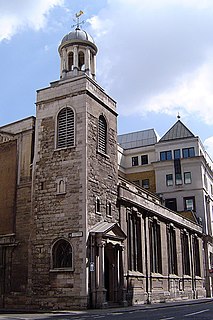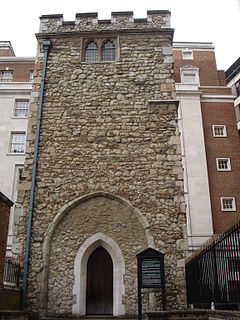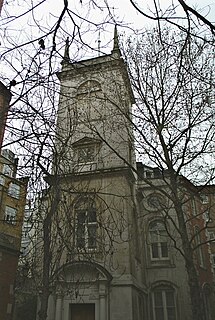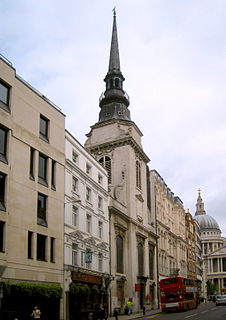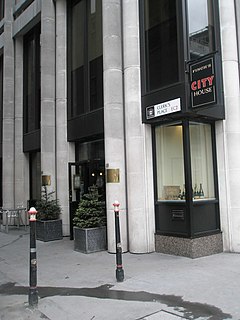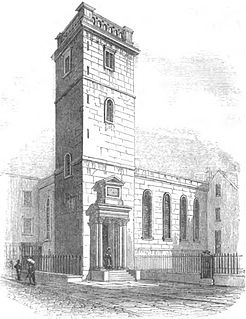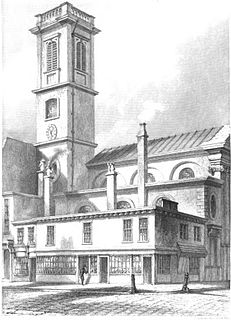| St Olave Hart Street | |
|---|---|
 | |
| Location | Hart Street, City of London |
| Country | United Kingdom |
| Denomination | Church of England |
| Previous denomination | Roman Catholic |
| Website | http://www.sanctuaryinthecity.net/St-Olaves.html |
| Architecture | |
| Heritage designation | Grade I listed building |
| Style | Perpendicular Gothic |
| Years built | 1450 |
| Specifications | |
| Bells | 8 – Hung for full circle ringing |
| Administration | |
| Parish | St Olave's Hart Street |
| Diocese | London |
| Division | Archdeaconry of London |
| Subdivision | The City Deanery |
St Olave Hart Street is a Church of England church in the City of London, located on the corner of Hart Street and Seething Lane near Fenchurch Street railway station.

The Church of England is the established church of England. The Archbishop of Canterbury is the most senior cleric, although the monarch is the supreme governor. The Church of England is also the mother church of the international Anglican Communion. It traces its history to the Christian church recorded as existing in the Roman province of Britain by the third century, and to the 6th-century Gregorian mission to Kent led by Augustine of Canterbury.

The City of London is a city and county that contains the historic centre and the primary central business district (CBD) of London. It constituted most of London from its settlement by the Romans in the 1st century AD to the Middle Ages, but the agglomeration has since grown far beyond the City's borders. The City is now only a tiny part of the metropolis of London, though it remains a notable part of central London. Administratively, it forms one of the 33 local authority districts of Greater London; however, the City of London is not a London borough, a status reserved for the other 32 districts. It is also a separate county of England, being an enclave surrounded by Greater London. It is the smallest county in the United Kingdom.

Fenchurch Street railway station, also known as London Fenchurch Street, is a central London railway terminus in the southeastern corner of the City of London. It takes its name from its proximity to Fenchurch Street, a key thoroughfare in the City. The station and all trains are operated by c2c. Services run on lines built by the London and Blackwall Railway (L&BR) and the London, Tilbury and Southend Railway (LTSR) to destinations in east London and south Essex, including Upminster, Grays, Basildon, Southend and Shoeburyness.
Contents
- History
- Architecture
- Bells
- Organ
- Peter Turner
- Notable people associated with the church
- Gallery
- See also
- References
- Bibliography
- External links
John Betjeman described St Olave's as "a country church in the world of Seething Lane." [1] The church is one of the smallest in the City and is one of only a handful of medieval City churches that escaped the Great Fire of London in 1666. [2] In addition to being a local parish church, St Olave's is the Ward Church of the Tower Ward of the City of London. [3]

Sir John Betjeman was an English poet, writer, and broadcaster who described himself in Who's Who as a "poet and hack". He was Poet Laureate of the United Kingdom from 1972 until his death.

The Great Fire of London was a major conflagration that swept through the central parts of the English city of London from Sunday, 2 September to Thursday, 6 September 1666. The fire gutted the medieval City of London inside the old Roman city wall. It threatened but did not reach the aristocratic district of Westminster, Charles II's Palace of Whitehall, and most of the suburban slums. It consumed 13,200 houses, 87 parish churches, St Paul's Cathedral, and most of the buildings of the City authorities. It is estimated to have destroyed the homes of 70,000 of the city's 80,000 inhabitants.

Tower is one of the 25 wards of the City of London and takes its name from its proximity to the Tower of London. The ward covers the area of the City that is closest to the Tower.

















